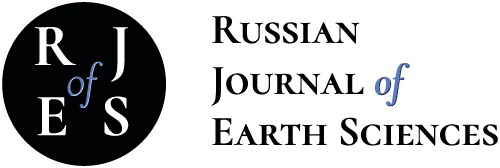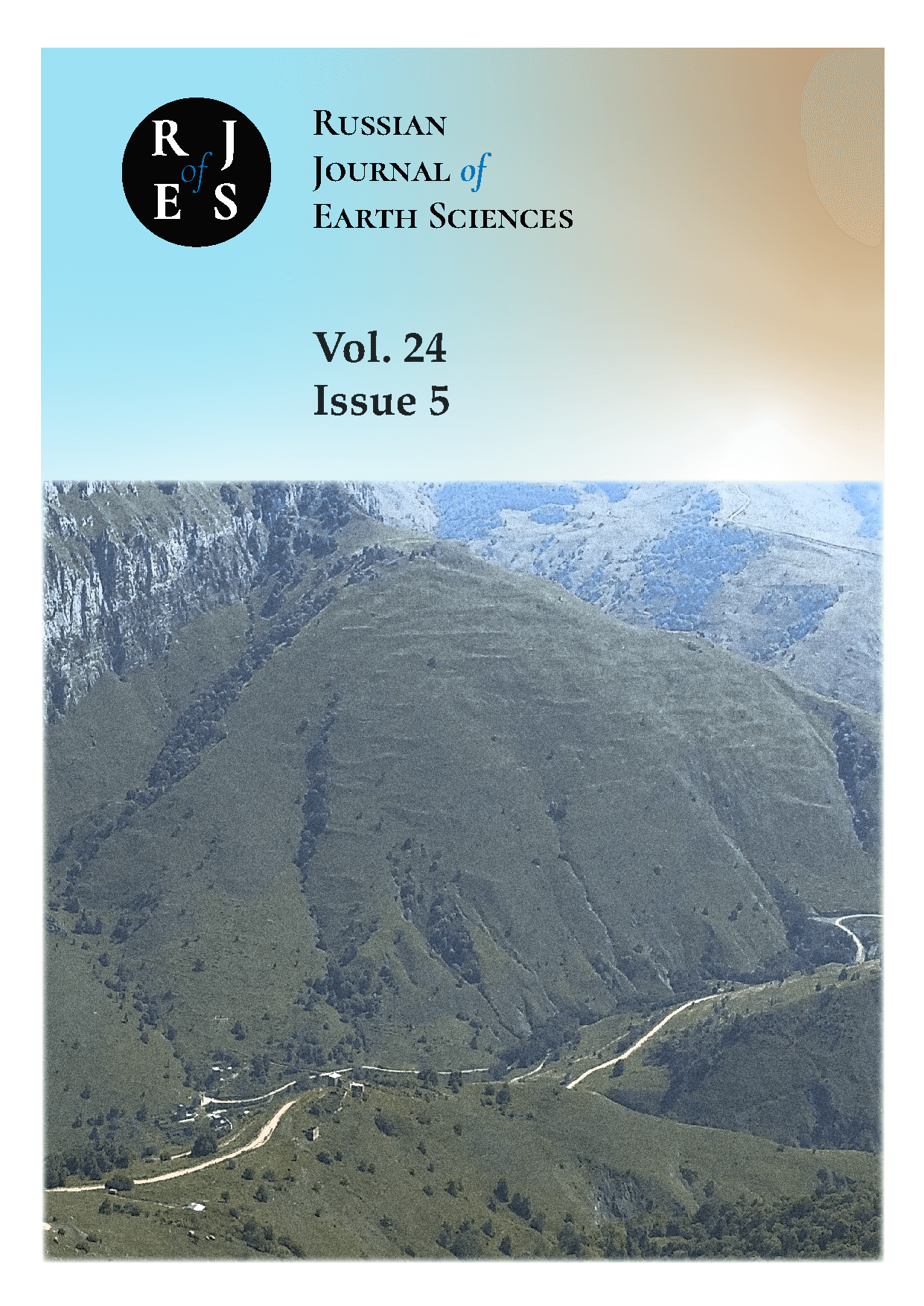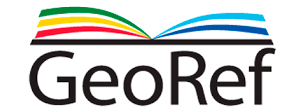Moscow, Russian Federation
VAK Russia 2.8.6
VAK Russia 1.6.11
VAK Russia 1.6.3
VAK Russia 1.2.2
VAK Russia 1.3.2
VAK Russia 1.6
UDC 552.08
UDC 552.12
UDC 552.51
UDC 553.98
UDC 616-073.756.8
UDC 531.731.43
UDC 539.217.1
UDC 539.217
UDC 55
UDC 550.34
UDC 550.383
CSCSTI 52.47
CSCSTI 37.31
CSCSTI 37.01
CSCSTI 37.15
CSCSTI 37.25
CSCSTI 38.01
CSCSTI 36.00
CSCSTI 37.00
CSCSTI 38.00
CSCSTI 39.00
CSCSTI 52.00
Russian Classification of Professions by Education 05.06.01
Russian Classification of Professions by Education 03.04.01
Russian Classification of Professions by Education 21.02.01
Russian Classification of Professions by Education 21.05.05
Russian Library and Bibliographic Classification 263
Russian Library and Bibliographic Classification 260
Russian Library and Bibliographic Classification 222
Russian Library and Bibliographic Classification 221
Russian Library and Bibliographic Classification 26
Russian Trade and Bibliographic Classification 6335
Russian Trade and Bibliographic Classification 6338
Russian Trade and Bibliographic Classification 6339
Russian Trade and Bibliographic Classification 6139
Russian Trade and Bibliographic Classification 63
BISAC JNF037060 Science & Nature / Earth Sciences / Rocks & Minerals
BISAC NAT030000 Rocks & Minerals
BISAC TEC009150 Civil / Soil & Rock
BISAC SCI SCIENCE
The paper presents the results of pore space studies of highly porous reservoir rocks of underground gas storage (UGS) facilities using the digital analysis of computed microtomography images. The methodology of complex nondestructive analysis of structural and filtration-capacitance properties has been developed. Structural heterogeneities and rock fracturing were evaluated. 3D-models of specimen inner space were created on the basis of multi-scale images. The values of open and closed porosity, geodesic tortuosity were calculated, the characteristics of percolation paths in the studied rocks were analyzed for different directions of intrusion. Conclusions were made about the homogeneity of percolation path distribution over the rock volume. The spatial distribution of porosity in the rocks was studied, and porometry analysis of the rocks was carried out. Numerical modeling of filtration processes on the obtained structures in the framework of Stokes approximation for three selected directions in the rock by means of GeoDict software was carried out. It is shown that there is no pronounced dependence of changes in filtration properties in the selected directions on the quantitative characteristics of the pore space. The conclusion is made about the degree of anisotropy of filtration-capacitance properties of rocks. The good correspondence of the characteristics measured in the course of digital analysis with in-situ data and experimentally obtained laboratory values is shown. The described technique allows to simplify data acquisition on the characteristics of fine-grained reservoir rocks, and is designed to extend the approaches to nondestructive analysis of core material. Combined application of the proposed methodology of digital analysis of low-strength reservoirs and laboratory geomechanical core testing is one of the stages in the development of a comprehensive approach to determining the parameters of safe operation of gas wells and reducing the risks of sanding in fields with weakly cemented reservoirs.
reservoir porosity, filtration-capacitance properties, CT scanning of rocks, digital core analysis, numerical modeling of filtration flow, permeability anisotropy.
1. Aliyev Z. S. and Kotlyarova E. M. Approximate method of creation and operation of UGS in layers of heterogeneous thickness using horizontal wells // Environmental responsibility of oil and gas enterprises. — Amirit, 2017. — EDN: https://elibrary.ru/ZBVNGD.
2. Garayshin A. S. and Kantyukov R. R. Selecting Formation-Accumulator for Industrial Waste Disposal of Arbuzovsky Underground Gas Storage Facility // Georesursy. — 2017. — Vol. 1, no. 19. — P. 82–86. — DOI:https://doi.org/10.18599/grs.19.1.13. — EDN: https://elibrary.ru/YRWLOV.
3. Grishin D. V. Complex technology for increasing the productivity of underground gas storage wells in conditions of reservoir destruction : PhD thesis / Grishin D. V. — 2019. — EDN: https://elibrary.ru/GYWDSR.
4. Karev V. I., Kovalenko Yu. F., Khimulya V. V., et al. Physical modeling of directional unloading method // Gazovaya promyshlennost’. — 2021. — No. 7. — P. 66–73. — EDN: https://elibrary.ru/QJFUXF.
5. Krivoshchekov S. N. and Kochnev A. A. Determination of reservoir properties of reservoir rocks using X-ray imaging core // Master’s journal. — 2014. — Vol. 1. — P. 120–128. — EDN: https://elibrary.ru/SKFCHR.
6. Maksimov V. M., Dmitriev N. M. and Antonevich Yu. S. Tensor character effects of the relative phase permeabilities during mutial gas diplasement by water through anisotropic porous media // Georesources, geoenergetics, geopolitics. — 2010. — 1(1). — P. 25–34. — EDN: https://elibrary.ru/SIYMFR.
7. Khimulia V. V. and Barkov S. O. Analysis of changes in the internal structure of low-permeability reservoir rocks by means of computed tomography after implementation of the directional unloading method // Actual Problems of Oil and Gas. — 2022. — No. 39. — P. 27–42. — DOI:https://doi.org/10.29222/ipng.2078-5712.2022-39.art3.
8. Khimulia V. V., Barkov S. O. and Shevtsov N. I. Digital study of pore space and structural properties of a gas condensate field reservoir based on computed tomography IMA // Processes in geoenvironments. — 2024a. — No. 1. — P. 2332– 2340. — EDN: https://elibrary.ru/CSQXZO.
9. Backeberg N. R., Iacoviello F., Rittner M., et al. Quantifying the anisotropy and tortuosity of permeable pathways in clay-rich mudstones using models based on X-ray tomography // Scientific Reports. — 2017. — Vol. 7, no. 1. — DOI:https://doi.org/10.1038/s41598-017-14810-1.
10. Bali A. and Singh Sh. N. A Review on the Strategies and Techniques of Image Segmentation // 2015 Fifth International Conference on Advanced Computing & Communication Technologies. — IEEE, 2015. — P. 113–120. — DOI:https://doi.org/10.1109/ACCT.2015.63.
11. Chen M., Bai M. and Roegiers J.-C. Permeability tensors of anisotropic fracture networks // Mathematical Geology. — 1999. — Vol. 31, no. 4. — P. 335–373. — DOI:https://doi.org/10.1023/A:1007534523363.
12. Clavaud J.-B., Maineult A., Zamora M., et al. Permeability anisotropy and its relations with porous medium structure // Journal of Geophysical Research: Solid Earth. — 2008. — Vol. 113, B1. — DOI:https://doi.org/10.1029/2007JB005004.
13. Daish C., Blanchard R., Gulati K., et al. Estimation of anisotropic permeability in trabecular bone based on microCT imaging and pore-scale fluid dynamics simulations // Bone Reports. — 2017. — Vol. 6. — P. 129–139. — DOI:https://doi.org/10.1016/j.bonr.2016.12.002.
14. Holzer L., Marmet Ph., Fingerle M., et al. Tortuosity and Microstructure Effects in Porous Media: Classical Theories, Empirical Data and Modern Methods. — Springer International Publishing, 2023. — DOI:https://doi.org/10.1007/978-3-031-30477-4.
15. Khimulia V. V. Digital Examination of Pore Space Characteristics and Structural Properties of a Gas Condensate Field Reservoir on the Basis of 𝜇CT Images // Proceedings of the 9th International Conference on Physical and Mathematical Modelling of Earth and Environmental Processes. — Springer Nature Switzerland, 2024. — P. 23–34. — DOI:https://doi.org/10.1007/978-3-031-54589-4_3.
16. Khimulia V. V., Karev V., Kovalenko Yu., et al. Changes in filtration and capacitance properties of highly porous reservoir in underground gas storage: CT-based and geomechanical modeling // Journal of Rock Mechanics and Geotechnical Engineering. — 2024. — Vol. 16, no. 8. — P. 2982–2995. — DOI:https://doi.org/10.1016/j.jrmge.2023.12.015.
17. Kovářová K., Ševčík R. and Weishauptová Z. Comparison of mercury porosimetry and X-ray microtomography for porosity study of sandstones // Acta Geodynamica et Geomaterialia. — 2012. — Vol. 9, no. 4. — P. 168–178.
18. Krivoshchekov S., Kochnev A., Kozyrev N., et al. Factoring Permeability Anisotropy in Complex Carbonate Reservoirs in Selecting an Optimum Field Development Strategy // Energies. — 2022. — Vol. 15, no. 23. — P. 8866. — DOI:https://doi.org/10.3390/en15238866.
19. Linden S., Wiegmann A. and Hagen H. The LIR space partitioning system applied to the Stokes equations // Graphical Models. — 2015. — Vol. 82. — P. 58–66. — DOI:https://doi.org/10.1016/j.gmod.2015.06.003.
20. Math2Market GmbH. FlowDict: Single-Phase Fluid Flow. — 2024a. — URL: https://www.math2market.com/geodictsoftware/geodict-base-modules/simulation/flowdict (visited on 06/02/2024).
21. Math2Market GmbH. GeoDict - The Digital Material Laboratory. — 2024b. — URL: https://www.math2market.de (visited on 06/02/2024).
22. Mostaghimi P., Blunt M. J. and Bijeljic B. Computations of Absolute Permeability on Micro-CT Images // Mathematical Geosciences. — 2012. — Vol. 45, no. 1. — P. 103–125. — DOI:https://doi.org/10.1007/s11004-012-9431-4.
23. Pelissou C., Baccou J., Monerie Y., et al. Determination of the size of the representative volume element for random quasi-brittle composites // International Journal of Solids and Structures. — 2009. — Vol. 46, no. 14/15. — P. 2842–2855. — DOI:https://doi.org/10.1016/j.ijsolstr.2009.03.015.
24. Shreyamsha Kumar B. K. Image denoising based on non-local means filter and its method noise thresholding // Signal, Image and Video Processing. — 2012. — Vol. 7, no. 6. — P. 1211–1227. — DOI:https://doi.org/10.1007/s11760-012-0389-y.
25. Stenzel O., Pecho O., Holzer L., et al. Predicting effective conductivities based on geometric microstructure characteristics // AIChE Journal. — 2016. — Vol. 62, no. 5. — P. 1834–1843. — DOI:https://doi.org/10.1002/aic.15160.
26. Taud H., Martinez-Angeles R., Parrot J. F., et al. Porosity estimation method by X-ray computed tomography // Journal of Petroleum Science and Engineering. — 2005. — Vol. 47, no. 3/4. — P. 209–217. — DOI:https://doi.org/10.1016/j.petrol.2005.03.009.
27. Versteeg H. K. and Malalasekera W. An Introduction to Computational Fluid Dynamics: The Finite Volume Method. — Pearson (England) : Pearson Education Limited, 2007.
28. Wan Y., Pan Zh., Tang Sh., et al. An experimental investigation of diffusivity and porosity anisotropy of a Chinese gas shale // Journal of Natural Gas Science and Engineering. — 2015. — Vol. 23. — P. 70–79. — DOI:https://doi.org/10.1016/j.jngse.2015.01.024.
29. Wright H. M. N., Roberts J. J. and Cashman K. V. Permeability of anisotropic tube pumice: Model calculations and measurements // Geophysical Research Letters. — 2006. — Vol. 33, no. 17. — DOI:https://doi.org/10.1029/2006GL027224.















